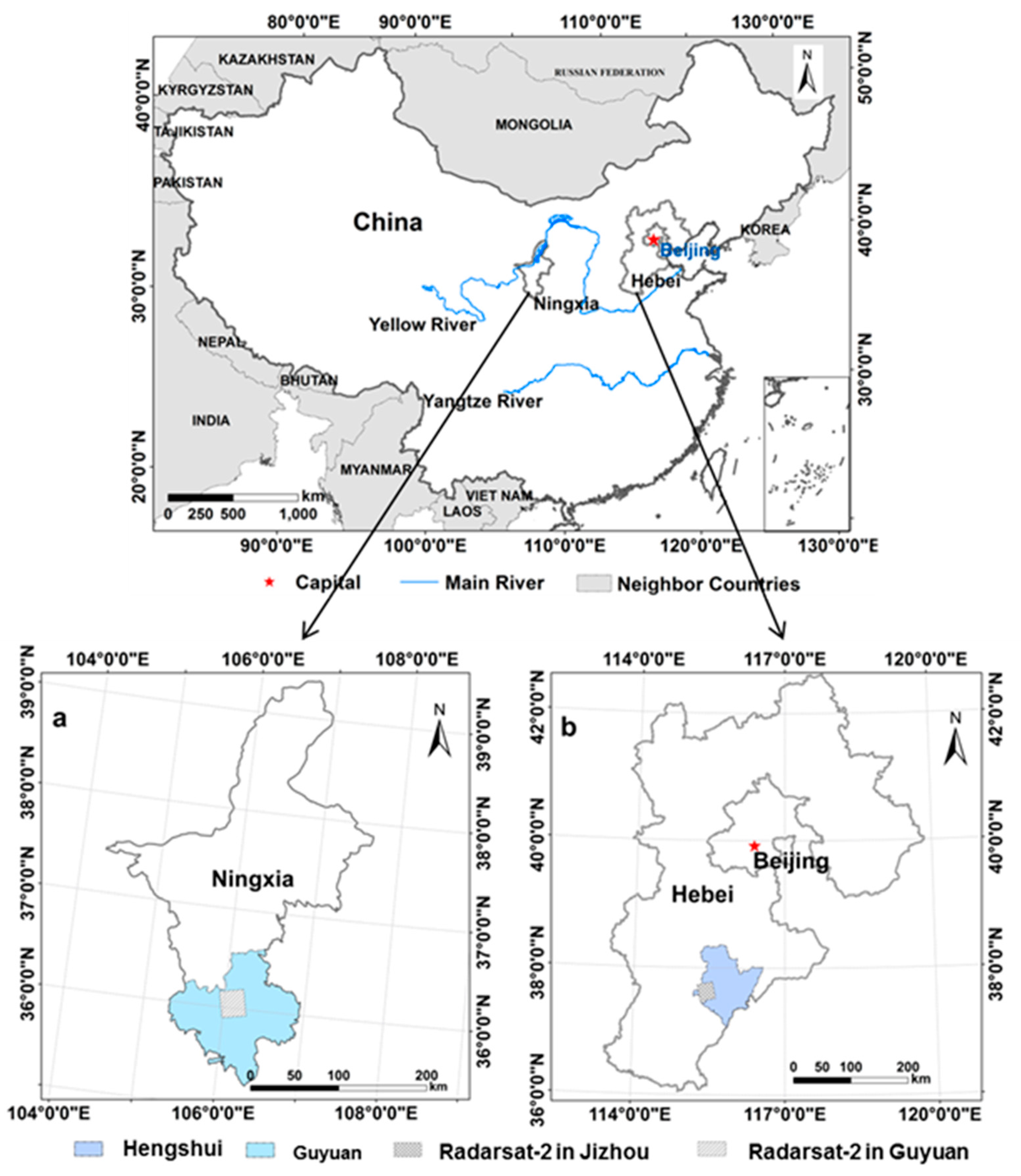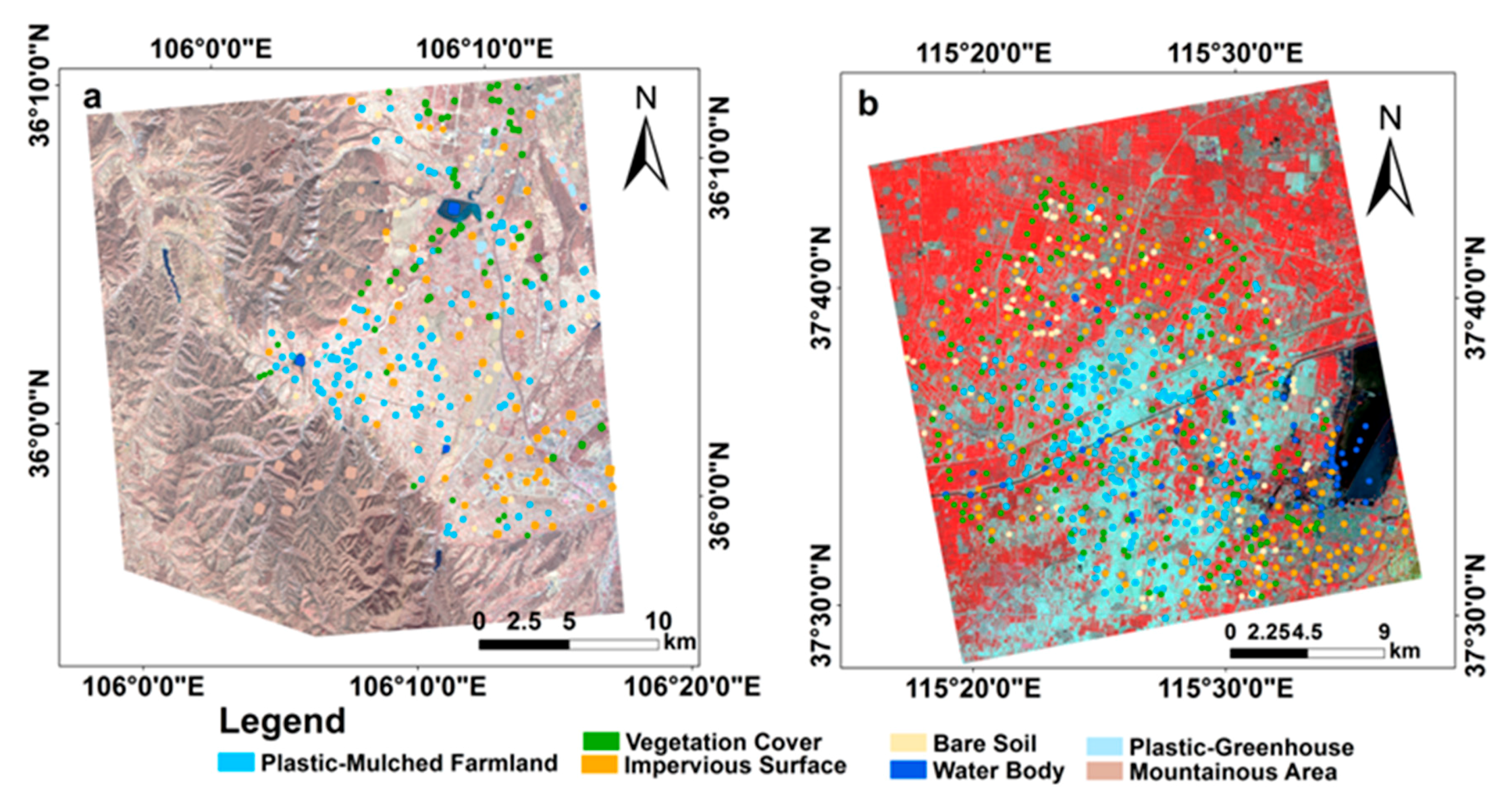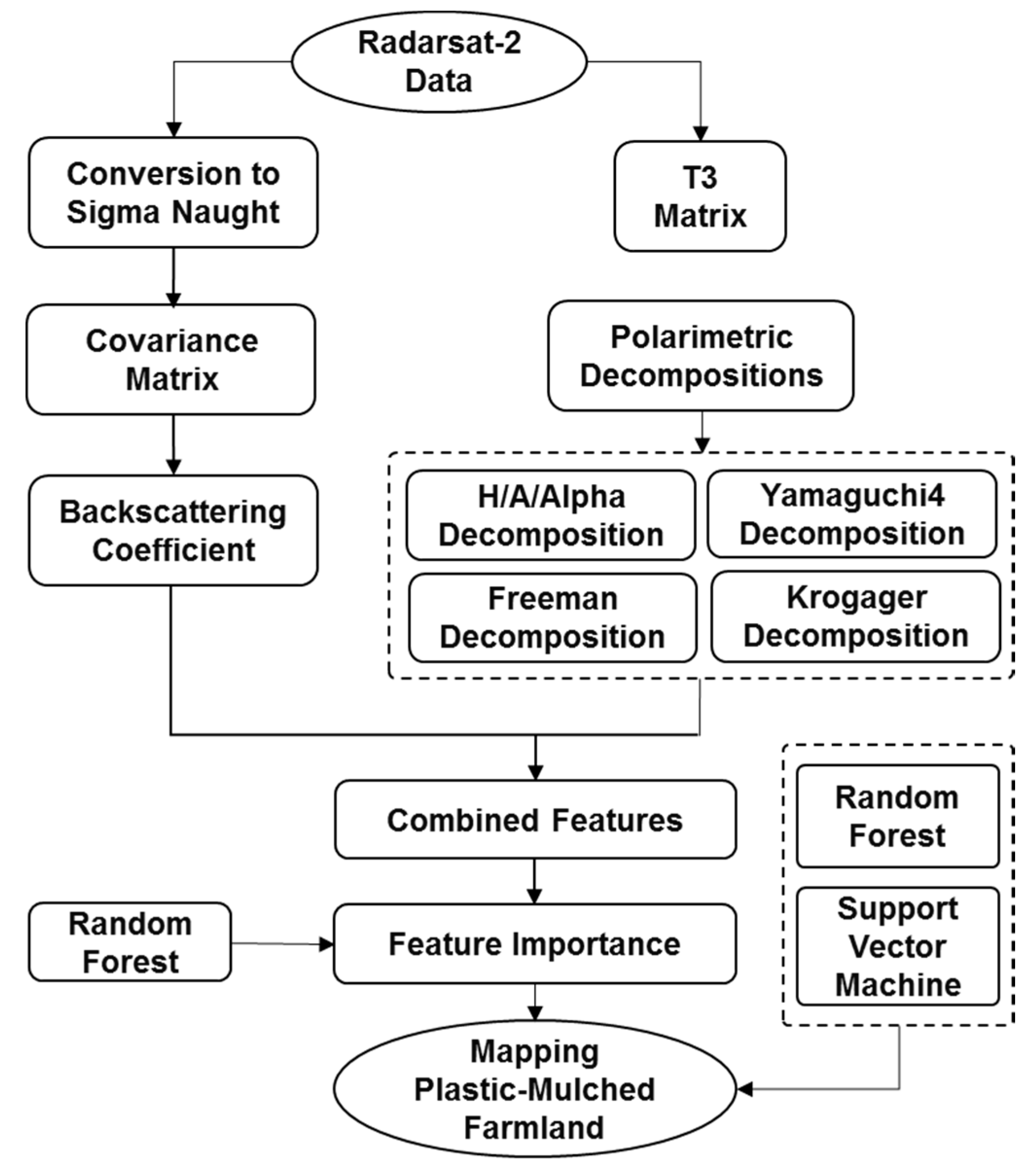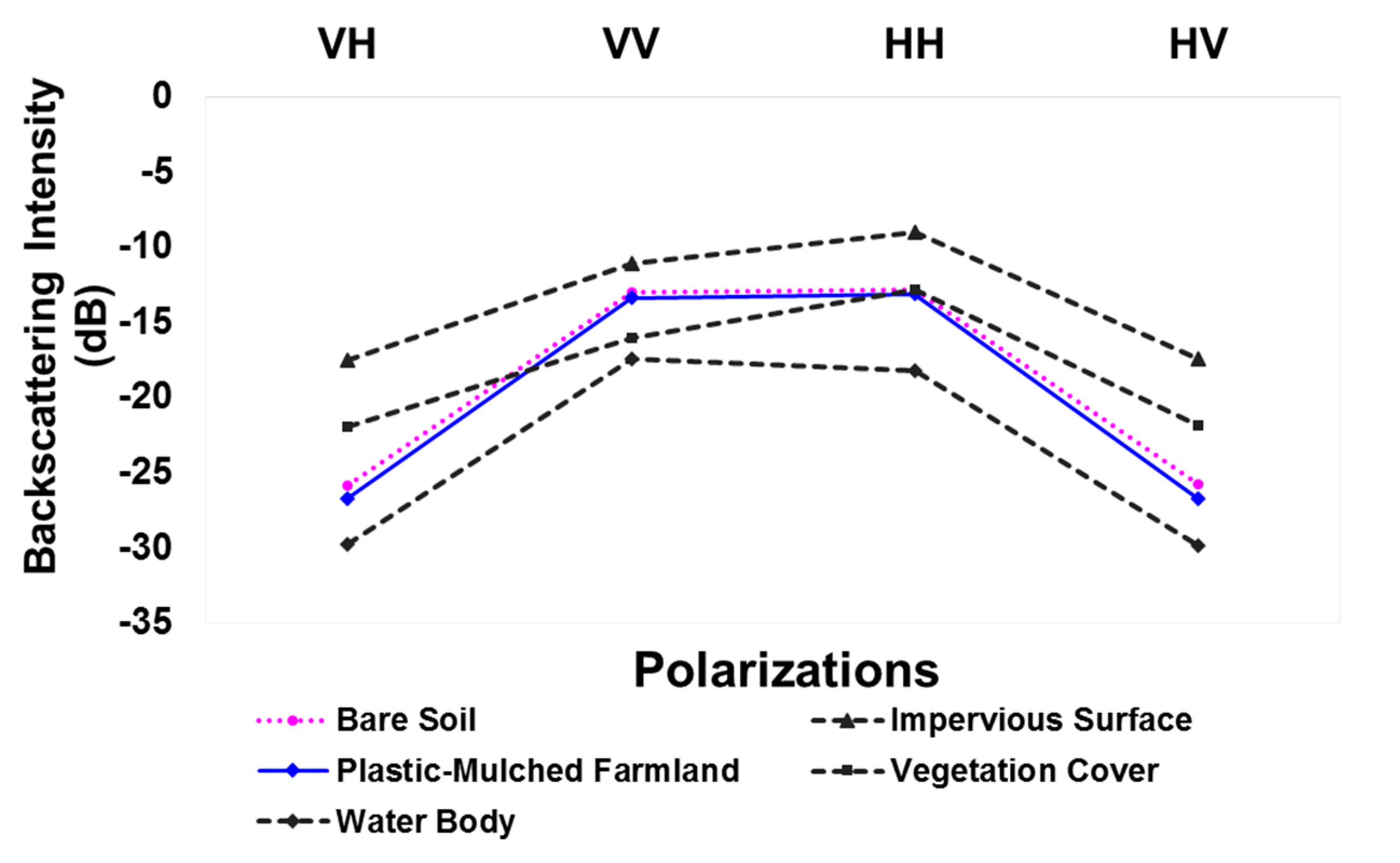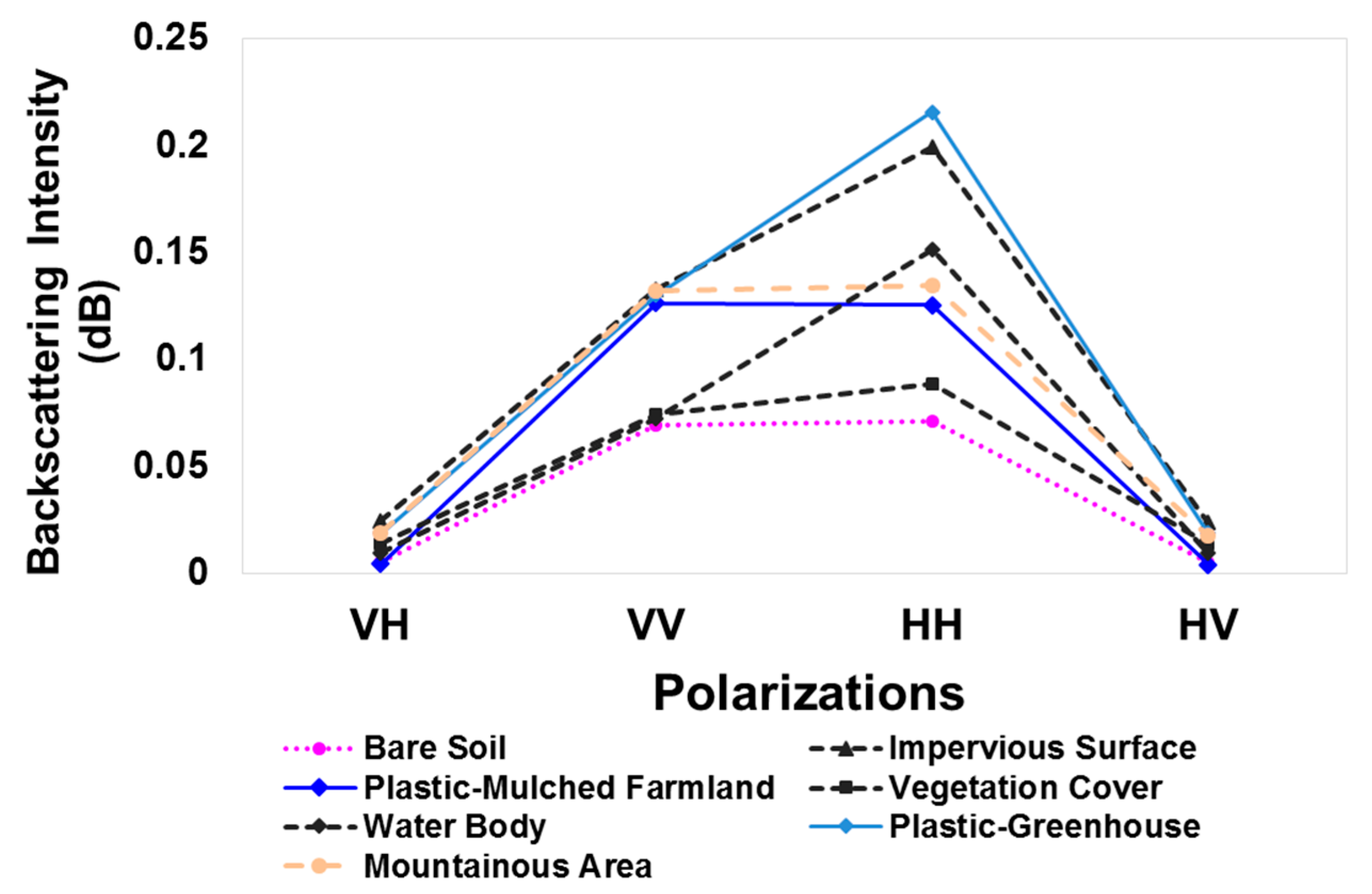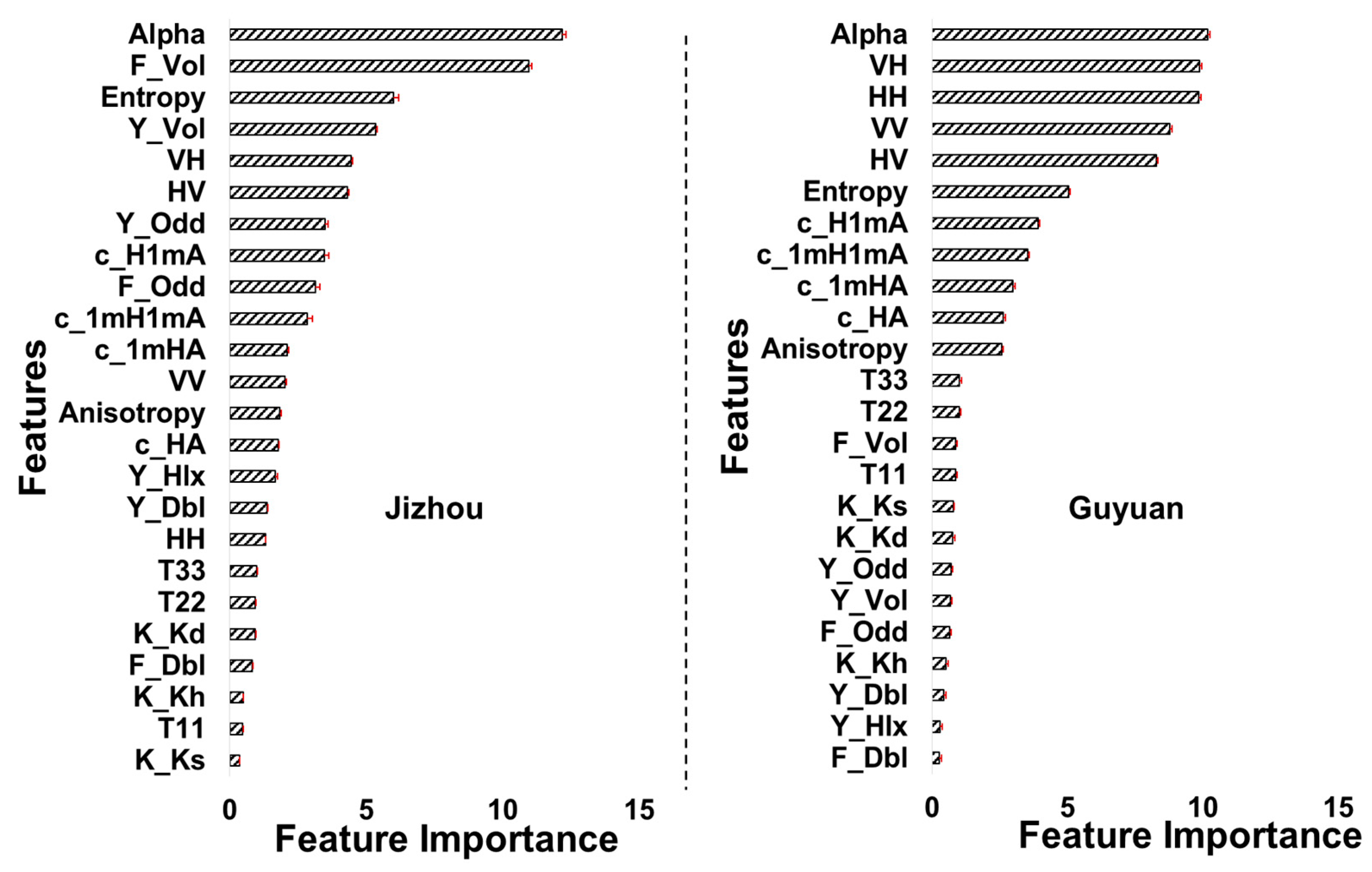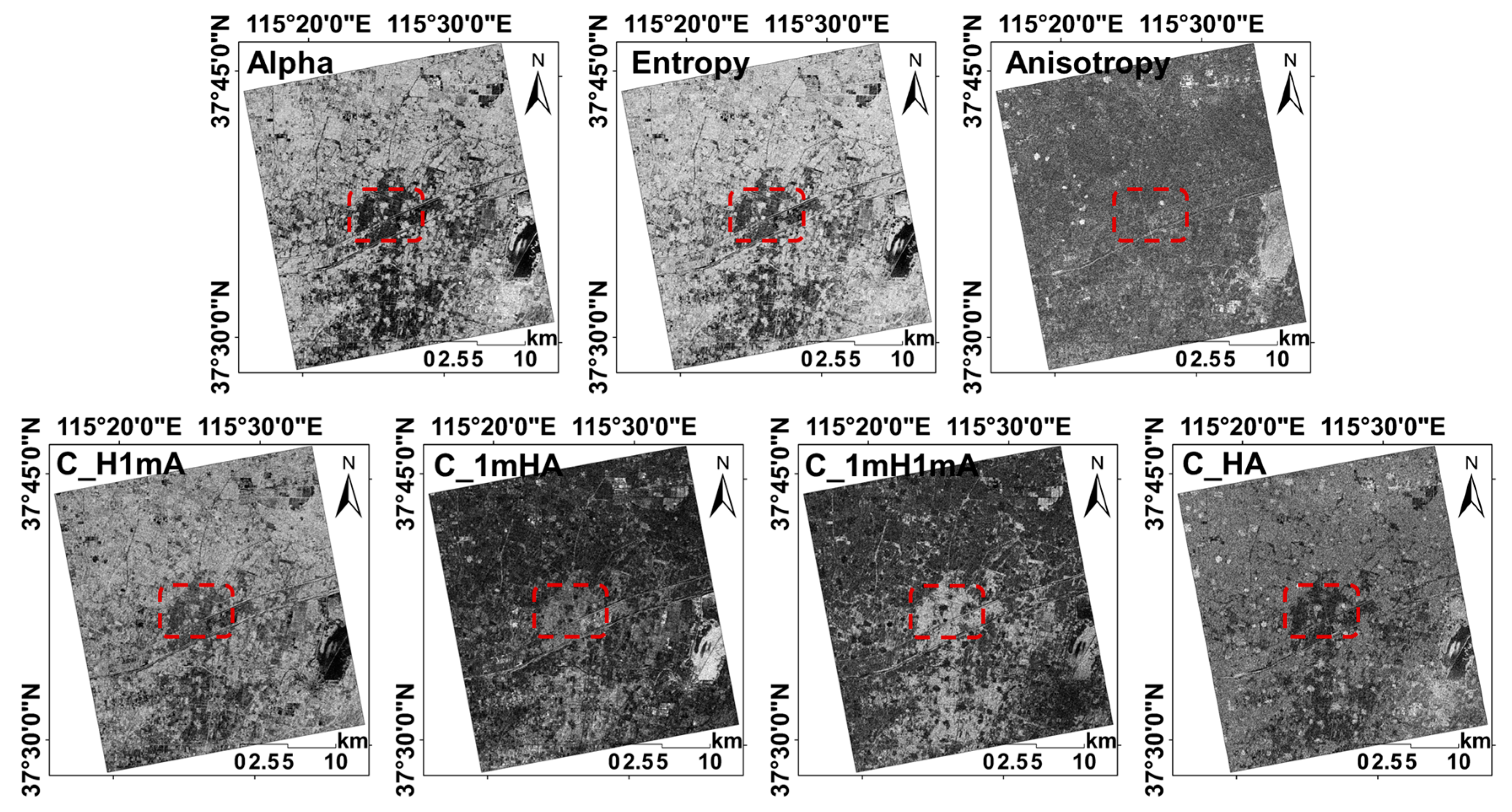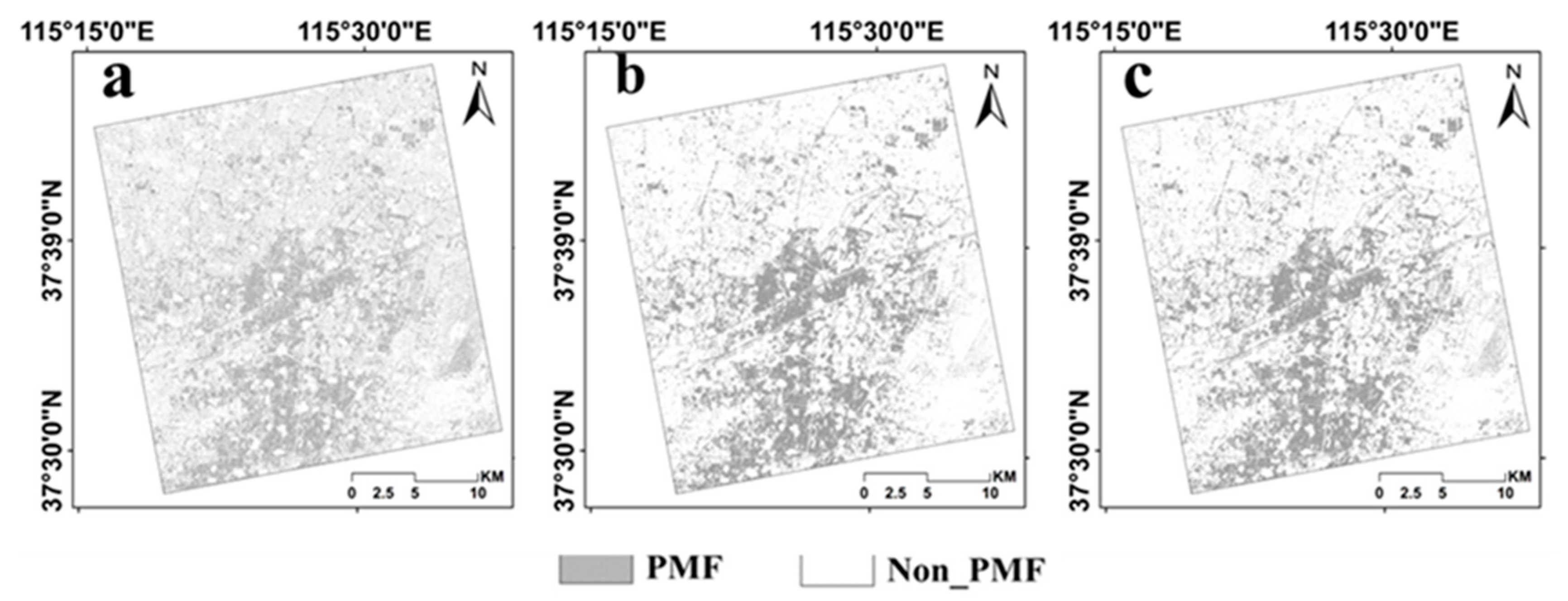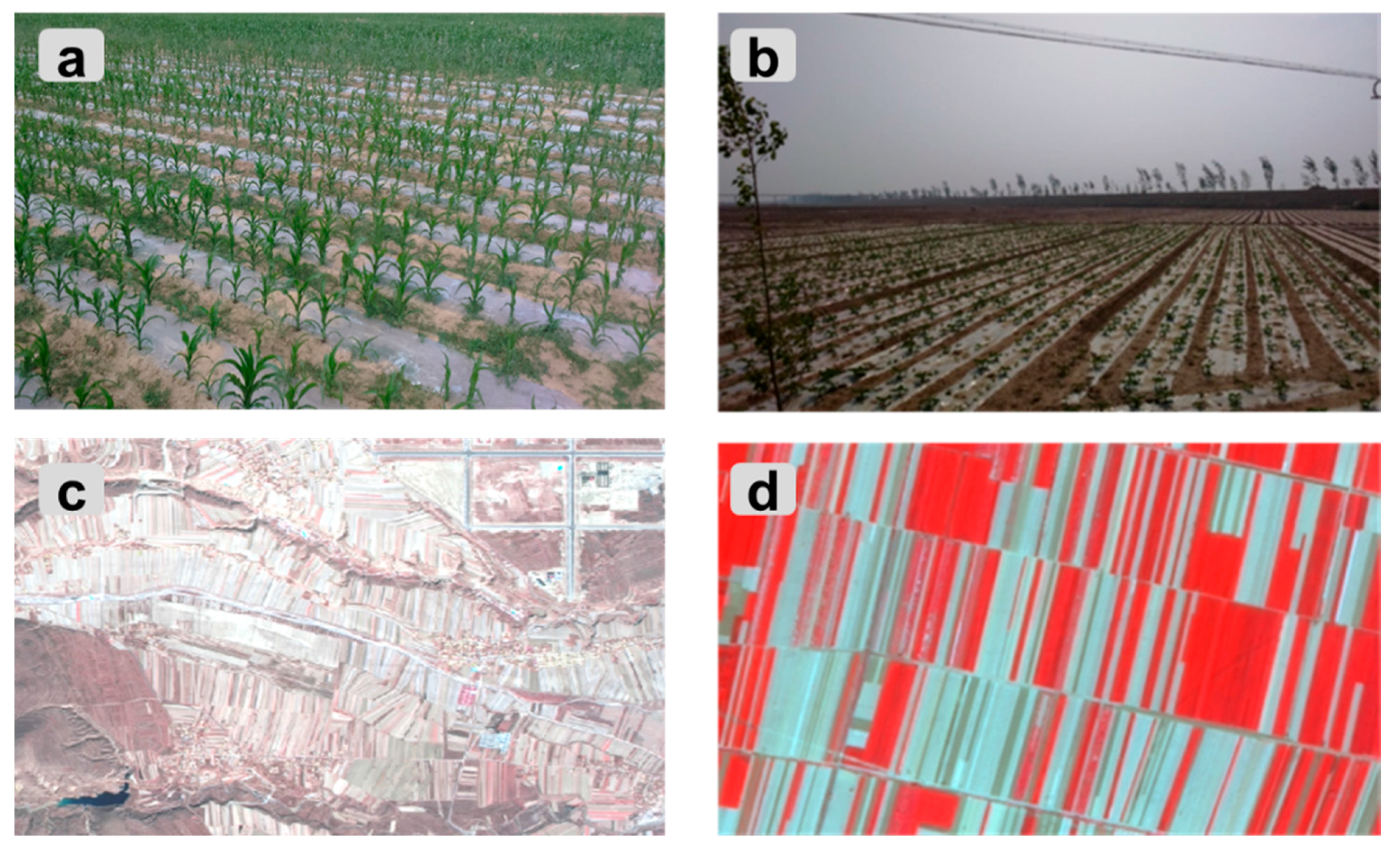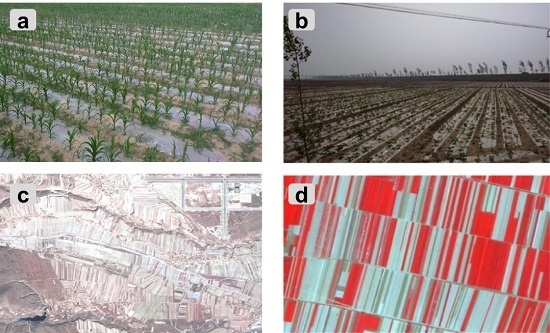1. Introduction
The practice of plastic mulching has changed agricultural production radically all over the world [
1]. Plastic mulching is a practice of tightly covering plastic film over the soil surface to promote crop growth and increase crop yield. Plastic mulching can protect crops from unfavorable growing conditions (droughts, coldness, heat, weeds and/or pests) and increase the crop yields. On the other hand, large-scale projects using this technique are expected to put further pressure on the environment, such as “white pollution”, soil degradation [
2,
3] and the alternation of the material and energy exchange [
4]. The environmental problems caused by Plastic-Mulched Farmland (PMF) expansion have been exacerbated in recent years [
2,
5], creating a pressing demand to optimize the use of plastic mulching. Thus, accurate mapping of PMF (obtaining the information about spatial pattern and amount of PMF according its specific signature via remote sensing technology) at a local or regional scale is needed for decision-makers and researchers. It is well-known that remote sensing is a technique to obtain the up-to-date information effectively over a large region and across long time span [
6]. During the recent decades, mapping land cover types with remote sensing data has drawn increasing attention and obtained many valuable results. The extraction of the specific land cover type, such as a water body [
7,
8], impervious surface [
9], snow and ice [
10,
11], vegetation cover classification [
12], has raised interests greatly.
In recent years, increasing attention has been paid to map the plasticulture landscape with remote sensing. But most of the researches were on mapping plastic greenhouses rather than PMF. The topic is relevant to passive remote sensing data with which plasticulture has been mapped by two main approaches: pixel-based and object-based classifiers. For example, Agüera et al. proposed a pixel-based approach for mapping plastic greenhouses using texture features from QuickBird images [
13,
14]. Carvajal et al. mapped plastic greenhouse using QuickBird and IKONOS images [
15]. Arcidiacono et al. presented an improved pixel-based approach for mapping crop-shelter coverage by using high-resolution satellite images [
16,
17]. Koc-San evaluated the performance of different pixel-based classifiers for differentiating glass and plastic greenhouses using WorldView-2 images [
18]. Recently, studies have developed an object-based approach for mapping plastic greenhouses using high spatial resolution images [
19,
20,
21]. All these studies mostly used high spatial resolution remote sensing images. Although the high spatial resolution images provided data for mapping plastic greenhouses efficiently in a fixed region, their application will be limited by a large spatial extent, large data storage and costly data procurement. More recently, studies developed an object-based approach for mapping plastic greenhouses using medium spatial resolution images [
22,
23,
24]. In addition, Levin et al. studied the spectral properties of various plastic polyethylene sheets using a field spectrometer and detected three major absorption features around 1218 nm, 1732 nm and 2313 nm [
25].
However, the spatial pattern of PMF is wider than that of plastic greenhouses in China, and the spectral response of PMF is changing more quickly than that of plastic greenhouses. Mapping PMF with remote sensing began in the last few years. Lu et al. presented a decision-tree classifier for mapping PMF in Xinjiang, China, with Landsat-5 images and obtained ideal results [
5]. However, plastic mulching in China was applied during the sowing stage, and the spectral reflectance of the PMF is influenced by the developing crops. Therefore, the detectable period of PMF is very short (one week to two weeks). Additionally, the long revisiting of the Landsat satellite limits its usage for PMF mapping, as it is difficult to capture the changing characteristic of PMF with crop phenology. For this, they, afterwards, performed an index-based threshold method for PMF mapping using a time series MODIS-NDVI (Moderate-resolution Imaging Spectrometer-Normalized Difference Vegetation Index) [
26] and also obtained an acceptable result. These two methods are limited by several factors: (1) the regional differences of PMF will limit the performance when applied to other regions; (2) when using low resolution imagery, some smaller PMF are lost, and mixed pixel phenomenon may become more serious, because of the small patch and fragmented agricultural land use patterns in China. Therefore, a comprehensive consideration of these issues is required for improving the robustness of the PMF mapping approach. For this, Hasituya et al. mapped the PMF by using multiple features, including spectral features, textural features, index features, thermal features and temporal features generated from the Landsat-8 imagery [
27,
28]. The results pointed out that the multi-temporal features perform better than the single temporal features; and the spectral features and index features are better than the textural features and thermal features. However, the textural features generated from the high resolution data of GF-1 (GaoFen-1, the first satellite in the Chinese High-resolution Earth Observation System (CHEOS)) perform better than its spectral features for PMF mapping [
29]. In addition, Lanorte et al. estimated and mapped agricultural plastic waste by using satellite images and obtained ideal results [
30]. By reviewing the published literature, we found that these studies regarding mapping of PMF with remote sensing are limited, and all used optical remote sensing data. Additionally, the usage of microwave remote sensing data, especially Synthetic Aperture Radar (SAR) data, is rather absent.
The approaches used in specific object mapping/detecting are generally divided into: (1) supervised and unsupervised classifiers; (2) sub-pixel based, per-pixel based and object-based classifiers according to the basic operating unit; (3) single-classifier and ensemble classifier algorithms based on the number of classifiers; and (4) index-based automatic extraction methods. The methods for mapping plastic greenhouses include conventional supervised classification, object-based methods, machine learning classifiers, index-based threshold methods, and so on. However, the methods for mapping PMF mainly include the Index-based Threshold methods, Decision Tree classifiers, Support Vector Machine (SVM) classifiers, Random Forest (RF) classifiers, and so on. The relevant studies reported that the machine learning algorithm is superior to the other supervised classifiers.
Compared with optical and thermal infrared remote sensing, SAR remote sensing has several advantages regarding the capability of all-weather and all-time observations, the ability to penetrate cloud cover and record the information about the structure, surface roughness, shape and dielectrics of the object [
31]. SAR data contain scattering information that can reveal the scattering mechanism of the objects. Therefore, SAR remote sensing plays a very important role in target recognition, classification and parameter inversion. With the rapid development over half a century, the SAR system has now formed a multi-band, multi-mode, multi-polarization and multi-resolution imaging technology system. The application domains of SAR remote sensing are also expanding from terrain mapping, land cover classification [
32,
33], crop type identifying [
34,
35,
36], crop phenology monitoring [
37], inversion of soil moisture [
38] and estimation of biomass and crop yield to snow cover monitoring, flooding mapping [
39], coastline monitoring [
40,
41] and sea surface environmental monitoring [
42,
43].
Polarimetric decomposition of SAR data is a technique for separating the complex scattering mechanism of an object. Polarimetric decomposition can simplify the complex scattering mechanism as several kinds of simple scattering mechanisms, which are related to the physical structure of targets, and can thus be used to classify land cover types [
33]. Thereby, we can analyze the scattering characteristics of the object and identify this object based on a simple scattering mechanism. Polarimetric decomposition can be classified into coherent decomposition based on a scattering matrix and non-coherent decomposition based on a covariance matrix or coherent matrix. Coherent decomposition includes Krogager decomposition, Huynen decomposition, Cameron decomposition, and so on. The non-coherent decomposition includes Freeman decomposition (three-component or two-component), Yamaguchi4 decomposition and Entropy/Anisotropy/Alpha (H/A/Alpha) decomposition [
44]. By these polarimetric decomposition methods, we can quantitatively express single scattering, double bounce scattering and random scattering intensity in the SAR scattering mechanism.
Plastic mulching changes the surface roughness and soil moisture. Therefore, the backscattering and polarimetric decomposition characteristics of the PMF are different from those of other objects theoretically. To provide more possibilities for PMF mapping with remote sensing, the current study provided new insights into the use of high resolution C-band SAR data for PMF mapping and evaluated the use of polarimetric decomposition of SAR data, which can be acquired independent of local weather and provide an information source complementary to optical remote sensing systems. The proposed methodology was based on the integration of backscattering intensity, polarimetric decomposition and machine learning algorithms. The main objectives of this study are (1) to examine the backscattering characteristic of PMF; (2) to mine the effective features of SAR data for PMF mapping, including the polarimetric decomposition features; and (3) to compare the performance of two different machine learning algorithms, namely RF and SVM.
4. Results
4.1. Importance of SAR Features for Mapping PMF
The RF algorithm was used to evaluate the importance of the total 24 features, which include backscattering intensity of different polarizations and the polarimetric decomposition descriptors.
Analysis of feature importance (
Figure 6) suggested that the descriptors derived from the H/A/Alpha decomposition were the most important features for mapping PMF. Additionally, the descriptors generated from the Yamaguchi4 and the Freeman decomposition were found to be the next most important features, while the contribution of Krogager decomposition descriptors was the smallest. The importance order of Radarsat-2 features for mapping PMF in Jizhou was ranked as Alpha, entropy, VH, HV, C_1mH1mA, C_H1mA, C_1mHA, C_HA, Y_Odd and anisotropy. Additionally, that in Guyuan was ranked as Alpha, VH, HH, VV, HV, entropy, C_H1mA, C_1mH1mA, C_1mHA, C_HA, and so on.
In
Figure 7, we display the images of the more important features for mapping PMF. It can be seen that the gray value of PMF on the images of Alpha, entropy, C_H1mA and C_HA is darker than that of other land cover types (except for water body). Additionally, the gray value of PMF is lighter than the other land cover types on the images of C_1mH1mA and C_1mHA.
4.2. Classification Accuracy of PMF with Radarsat-2 Data
The classification accuracies are displayed in
Table 4. The PMF classification accuracies indicated that the best result was obtained from all available combined features in Jizhou and Guyuan. The second best results were generated from the 90% features in Jizhou and Guyuan, respectively. Additionally, the worst results was generated from the backscattering intensity of different polarizations alone.
For Jizhou, the accuracies obtained from the backscattering coefficient intensity of different polarizations (VH, HH, VV and HV) alone were relatively low. The overall accuracy, producer’s accuracy and user’s accuracy from backscattering coefficient intensity were 59.75%, 68.29% and 52.71%, respectively. However, the accuracies were improved significantly by including the descriptors derived from the different polarimetric decomposition. The highest overall, producer’s and the user’s accuracies were improved to 74.82%, 85.31% and 67.56%, respectively, by combining the backscattering coefficient intensity of different polarizations with the descriptors derived from the different polarimetric decomposition algorithms. The accuracy improvement was about 15 percentage points on average.
For Guyuan, the accuracies from the backscattering coefficient intensity of different polarizations (VH, HH, VV and HV) alone were also relatively low. The overall accuracy, the producer’s accuracy and the user’s accuracy were 56.83%, 65.43% and 49.69%, respectively. This level of accuracy cannot meet the practical application requirements generally. However, the accuracies were improved significantly by combining the backscattering coefficient intensity with the polarimetric decomposition descriptors. Additionally, the highest overall, producer’s and the user’s accuracies achieved were 64.21%, 74.49% and 51.93%, respectively. The average accuracy improvement was about 15 percentage points, as well.
We can explain the contribution of the polarimetric decomposition descriptors for mapping PMF by comparing the approaches with and without polarimetric decomposition descriptors. The overall accuracy was increased by 15.07 percentage points in Jizhou and 7.38 percentage points in Guyuan when using RF with the polarimetric decomposition descriptors in classification. Additionally, the overall accuracy was increased by 15.20 percentage points in Jizhou and 10.00 percentage points in Guyuan when using SVM with the polarimetric decomposition descriptors in classification. Furthermore, the user’s and producer’s accuracies of PMF were improved also by employing the polarimetric decomposition descriptors. The producer’s accuracies for PMF were increased by 17.02 percentage points in Jizhou and 9.06 percentage points in Guyuan when using RF with the polarimetric decomposition descriptors in classification. When using SVM, the producer’s accuracies for PMF were increased by 18.30 percentage points in Jizhou and 3.31 percentage points in Guyuan. Additionally, the user’s accuracies for PMF were increased by 14.02 percentage points in Jizhou and 2.24 percentage points in Guyuan when using RF with the polarimetric decomposition descriptors in classification. When using SVM, the user’s accuracies for PMF were increased by 15.71 percentage points in Jizhou and 1.60 percentage points in Guyuan. From these accuracy improvements, we can confirm that the polarimetric decomposition descriptors make a great contribution toward PMF mapping in northern China.
In general, the inclusion of polarimetric decomposition descriptors can improve the overall accuracy by almost 7–15 percentage points. The RF classifiers were found to be more effective than the SVM classifiers both in Jizhou and in Guyuan.
After accuracy assessment, the Z test was applied to determine the statistical significance of each classification. The Z test values of highest and worst accuracy from the RF algorithm and the SVM algorithm are given in
Table 5, and the Z test values between pairs of features and classifiers in Jizhou and Guyuan are given in
Table 6.
Table 5 shows that the Z test value was greater than 99.26 when using both the RF and SVM algorithms for mapping PMF in Jizhou, and was greater than 5.63 in Guyuan. All these values were higher than 2.58. This indicates that the classifications are meaningful and significantly better than a random classification at the 99% confidence level.
Table 6 shows that the Z test value was 32.13 when comparing the highest and the worst accuracy generated from the RF algorithm for mapping PMF in Jizhou; and that was 29.83 when comparing the highest and the worst accuracy generated from the SVM algorithm for mapping PMF in Jizhou. This means that the performance of these two feature sets (the combined features of backscattering intensity and the polarimetric decomposition descriptors and the backscattering intensity alone) was significantly different (higher than 2.58) at the 99% confidence level when using RF and SVM.
For the different classifiers, the Z test value was 3.07 (higher than 2.58) when comparing the highest accuracy of RF and SVM, and the Z test value was 28.99 (higher than 2.58) when comparing the worst accuracy of RF and SVM. Therefore, the performance of RF was significantly better than SVM at the 99% confidence level.
In general, the combined features of the backscattering coefficient intensity of four polarizations and the polarimetric decomposition descriptors are superior to the individual features. Additionally, RF performed significantly better than SVM.
From the confusion matrices (
Table 7 for Jizhou and
Table 8 for Guyuan), it can be seen that the main cause for the low classification accuracy was the confusion between PMF and the other land cover types on the Radarsat-2 image. Especially, the confusion between PMF and the bare soil was very serious. The commission error and omission error of PMF and the bare soil were 56.11% and 8.16%, respectively, when using the backscattering intensity of four polarizations alone. Additionally, the commission error and omission error were decreased to 39.14% and 6.18% when introducing the polarimetric decomposition descriptors and optimizing them using RF. The commission error and omission error between PMF and water body were 25.97% and 5.99% when using the backscattering intensity alone. Additionally, the commission error and omission error between PMF and water body were reduced to 18.00% and 2.44%, respectively, when introducing the polarimetric decomposition descriptors and optimizing them using RF.
Figure 8 and
Figure 9 show the spatial distribution of PMF in Jizhou and Guyuan obtained from RF and SVM using Radarsat-2 data, respectively. The general spatial pattern is consistent with the knowledge obtained from the field survey. However, there is some visible classification noise that can be ascribed to speckle noise, carrying serious omission and commission error, of SAR data. Compared with the classification results from SVM, the misclassification of the RF classifier is less.
